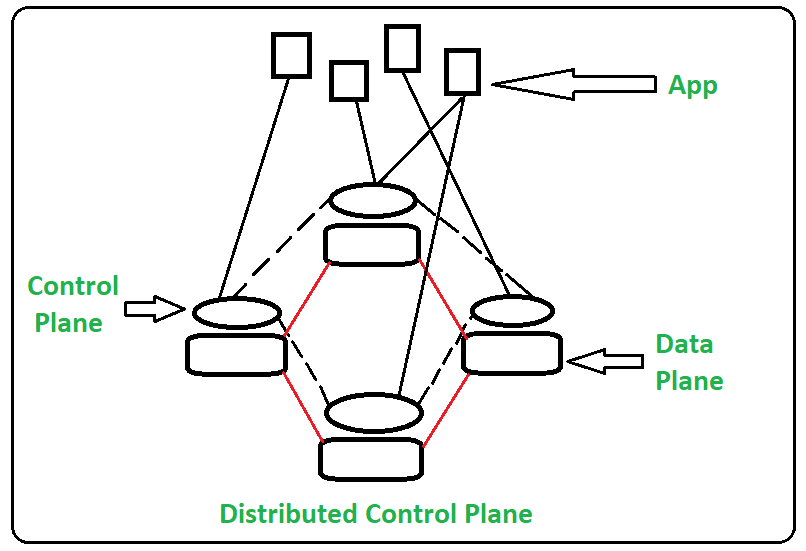Difference between Software Defined Network and Traditional Network
Last Updated :
11 May, 2023
1. Software Defined Network (SDN) : SDN stands for Software Defined Network which is networking architecture approach. It enables the control and management of network using software applications. Through Software Defined Network (SDN) networking behavior of entire network and its devices are programmed in centrally controlled manner through software applications using open APIs. Software Defined Network improves performance by network virtualization. In SDN software controlled applications or APIs work as basis of complete network management that may be directing traffic on network or to communicate with underlying hardware infrastructure. So in simple we can say SDN can create virtual network or it can control traditional network with the help of software.
Components of SDN:
SDN is comprised of three key components: the data plane, the control plane, and the application layer. The data plane is responsible for forwarding network traffic, while the control plane manages network infrastructure and makes decisions about how network traffic should be handled. The application layer consists of software applications that run on top of the SDN infrastructure.
Benefits of SDN:
SDN offers several key benefits over traditional networking approaches. For example, SDN allows for more efficient network management, as network administrators can automate many tasks that would otherwise be done manually. SDN also allows for more flexible and customizable network configurations, as network infrastructure can be reconfigured on the fly.
Applications of SDN:
SDN has a wide range of applications, from data center networking to wide area networks (WANs) and even the Internet of Things (IoT). SDN is particularly useful in situations where network infrastructure needs to be highly flexible and scalable.
The below figure illustrates architecture Software Defined Network :

Software Defined Network
2. Traditional Network : Traditional network refers to the old conventional way of networking which uses fixed and dedicated hardware devices such as routers and switches to control network traffic. Inability to scale and network security and Performance are the major concern now a days in the current growing business situation so that SDN is taking control to traditional network. Traditional network is static and based on hardware network appliances. Traditional network architecture was used by many companies till recent years but now a days due to its drawbacks Software Defined Network has been developed and in coming years it will be used more.
Components of Traditional Network:
Network devices: Traditional networks use physical network devices, such as routers, switches, and firewalls, to manage and direct network traffic.
Cabling: Traditional networks use physical cabling to connect network devices to each other.
Protocols: Traditional networks rely on standard networking protocols, such as TCP/IP and Ethernet, for communication between network devices.
Advantages of Traditional Network:
Well-established: Traditional networks are well-established and widely used in various organizations.
Predictable performance: Traditional networks offer predictable performance as network devices are configured based on specific requirements.
Familiarity: Traditional networks are familiar to network administrators and require minimal training.
Disadvantages of Traditional Network:
Limited scalability: Traditional networks have limited scalability due to the dependence on physical hardware devices.
Limited automation: Traditional networks have limited automation capabilities and require significant manual intervention.
Rigid architecture: Traditional networks have a rigid, hierarchical architecture that is difficult to modify or adapt to changing business needs.
The below figure illustrates the architecture of Traditional Network :

Traditional Network Architecture
Here are some similarities between Software Defined Network (SDN) and Traditional Network:
- Both SDN and traditional networks aim to provide network connectivity between devices.
- Both types of networks use standard networking protocols, such as TCP/IP and Ethernet, for communication between network devices.
- Both SDN and traditional networks have security concerns, such as unauthorized access, data breaches, and network attacks.
- Both types of networks can provide quality of service (QoS) features to ensure that critical applications receive the required bandwidth and priority.
Difference between SDN and Traditional Network :
| S.No. |
SDN |
TRADITIONAL NETWORK |
| 01. |
Software Defined Network is virtual networking approach. |
Traditional network is the old conventional networking approach. |
| 02. |
Software Defined Network is centralized control. |
Traditional Network is distributed control. |
| 03. |
This network is programmable. |
This network is non programmable. |
| 04. |
Software Defined Network is open interface. |
Traditional network is closed interface. |
| 05. |
In Software Defined Network data plane and control plane are decoupled by software. |
In traditional network data plane and control plane are mounted on same plane. |
| 06. |
It supports automatic configuration so it takes less time. |
It supports static/manual configuration so it takes more time. |
| 07. |
It can prioritize and block specific network packets. |
It leads all packets in the same way no prioritization support. |
| 08. |
It is easy to program as per need. |
It is difficult to program again and to replace existing program as per use. |
| 09. |
Cost of Software Defined Network is low. |
Cost of Traditional Network is high. |
| 10. |
Structural complexity is low in Software Defined Network. |
Structural complexity is high in Traditional Network. |
| 11. |
Extensibility is high in Software Defined Network. |
Extensibility is low in Traditional Network. |
| 12. |
In SDN it is easy to troubleshooting and reporting as it is centralized controlled. |
In Traditional network it is difficult to troubleshoot and report as it is distributed controlled. |
| 13. |
Its maintenance cost is lower than traditional network. |
Traditional network maintenance cost is higher than SDN. |
Conclusion :
The main differences between SDN and traditional networks are their architecture, control plane, configuration and management, programmability, scalability, security, and cost. While traditional networks are still widely used, SDN networks are becoming increasingly popular due to their flexibility, automation, and cost-effectiveness.
Like Article
Suggest improvement
Share your thoughts in the comments
Please Login to comment...